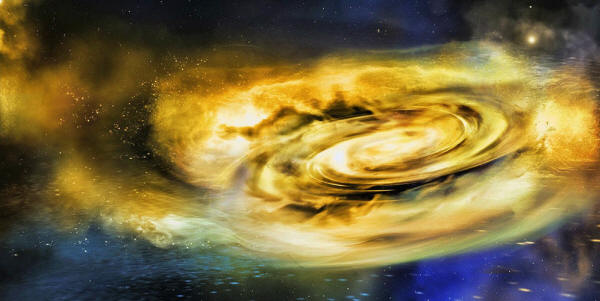|

by Katie Willis
January 22,
2018
from
Folio Website

Illustration of strong winds
disrupting the outer disc of material
surrounding a stellar-mass black hole
(Image:
NASA/Swift/
A.
Simonnet, Sonoma State University)
Study sheds new light on how
black holes consume mass and affect
their environment.
New research shows the first evidence of strong winds around black
holes throughout bright outburst events in which black holes rapidly
consume mass.
The study sheds new light on how mass transfers to black holes and
how they can affect the environment around them.
"Winds must
blow away a large fraction of the matter a black hole could
eat,'' said
Bailey Tetarenko, a University of Alberta PhD student and
lead author on the study.
"In one of our
models, the winds removed 80 per cent of the black hole's
potential meal."
The research was
conducted by an international team of researchers, led by Bailey Tetarenko
and scientists in the University of Alberta's
Department
of Physics.
Examining data from
three international space agencies spanning 20 years, the scientists
used new statistical techniques to study outbursts from stellar-mass
black hole X-ray binary systems.
They saw evidence
of consistent and strong winds surrounding black holes throughout
outbursts. Until now, strong winds had only been seen in limited
parts of these events.
They also observed
that stellar-mass black holes have the capacity to consume
everything within a three- to 150- kilometer radius, depending on
their size.
"Not even light
can escape from this close to a black hole," explained
Gregory Sivakoff, an associate professor of physics and
co-author.
Other, much larger black holes, called supermassive
black holes, appear to have affected the formation of entire
galaxies.
"But even
supermassive black holes are smaller than our solar system.
While they are small, black holes can have surprisingly large
effects," explained Sivakoff.
So, what exactly
causes these winds in space?
For now, it remains a mystery...
"We think
magnetic fields play a key role. But we'll need to do a great
deal of future investigation to understand these winds," said Craig
Heinke, associate professor of physics and co-author.
"Strong
Disk Winds Traced throughout Outbursts in Black-Hole X-ray Binaries"
was published by Nature.
This work was
completed by,
-
Bailey
Tetarenko, Craig Heinke and Gregory Sivakoff at the
University of Alberta
-
Jean-Pierre
Lasota at the Institut d'Astrophysique de Paris and Nicolaus
Copernicus Astronomical Centre in Warsaw
-
Guillaume
Dubus at the Institut de Planétologie et d'Astrophysique de
Grenoble
Data were collected
from five international X-ray observatories:
-
NASA's
Rossi X-ray Timing Explorer
-
the Neil
Gehrels Swift Observatory
-
the Chandra
X-Observatory
-
the Japan
Aerospace Exploration Agency's Monitor of All-Sky Image
Telescope on the International Space Station
-
the
European Space Agency's X-ray Multi-Mirror Mission (XMM-Newton)
Support for this
work was provided by,
-
the Natural
Sciences and Engineering Research Council of Canada
-
the
National Science Foundation
-
the Polish
National Science Centre through an OPUS grant
-
the French
Space Agency CNES
|


